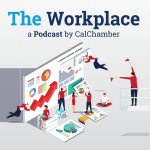In Episode 66 of The Workplace podcast, CalChamber Executive Vice President and General Counsel Erika Frank and employment law expert Jennifer Shaw discuss what employers should consider when monitoring employees working remotely and provide key takeaways for evaluating the performance of remote workers.
While telework is not a new concept, Frank says, it is new to many employers. And even for employers who previously allowed telecommuting, it’s new to have so many employees working remotely. Many employers may now be asking themselves: how can we evaluate job performance?
Considerations
Shaw remarks that while there are many temptations in the home setting, some people are able to multitask and thrive in that environment.
When it comes to monitoring how employees use their time during work hours, employers should consider the functions of nonexempt and exempt workers. Whereas exempt workers are paid for the projects or work done as a whole, nonexempt workers fulfill quantifiable work tasks, such as inputting a specified amount of data or answering phone calls for a specific amount of time, Shaw explains.
Employers also should keep in mind that just as their company is working from home, many clients also are at home, which means that the demand a business typically sees will slow down, Shaw says. Therefore, employers should expect and be understanding of the fact that some of their employees will have less work to do.
Monitoring Software
Monitoring software that tracks what employees do on company computers is available, Shaw says, but it doesn’t work very effectively. She explains that monitoring software does not work well if an employee has to connect to a company’s network from a remote desktop.
Moreover, while the software may tell an employer, for example, that “Joe” was on social media for an hour, Joe could have visited Facebook for 5 minutes at a time, which added up to an hour, Frank says.
And this is where employers should decide how they want to spend their time, Shaw points out. For example, can an employee use the computer while taking meal or rest breaks? And if so, does the employer want to take the time to match up each minute to confirm that the employee was indeed on a break?
“It’s not as automated as you think. It’s not like you’re just going to get this easy report that says, ‘You have a problem employee,’” Shaw says.
A common misconception is that if an employee is not in the office, they’re not working. But what “Joe” is doing at home is what he has been doing at work, Frank adds.
Shaw agrees, mentioning that research shows that the habits employees demonstrate at the office are the same habits they have at home.
“So, if you’re upset about Joe’s…internet usage at home, you better start tracking him in the office,” she says.
The bottom line: if employers were not already actively monitoring remote workers before the COVID-19 crisis, they probably should not start doing so now.
“It’s probably not the best use of your time or money,” Frank says.
Shaw agrees.
“…[Monitoring software] is not some panacea that is going to spit out whether or not you have a good employee,” she says.
Tips for Evaluating Performance
For employers wanting to evaluate performance, Shaw and Frank suggested they:
• Check in weekly, either personally or through conference software such as Zoom, to engage employees and share new developments. Shaw points out that if an employee does not have much work to be done, he may not want to bring that up in a conference call. Therefore, checking in one-on-one periodically may be a good idea as well.
• Set expectations. Given the informal setting of telework, it’s very important to set expectations, Shaw says. For example, you may tell an employee that they are expected to respond to emails within a specific amount of time. To determine expectations for a particular job, Shaw recommends that employers should treat it as though they are writing a job description by outlining what the employee is supposed to be doing and how that will be measured.
Subscribe to The Workplace
Subscribe to The Workplace on iTunes, Google Play, Stitcher, PodBean and Tune In.
To listen or subscribe, visit www.calchamber.com/theworkplace.


